
HAPPY CANADA’S 152nd BIRTHDAY!
BONNE FÊTE DU CANADA!

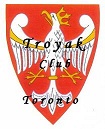
“TROYAK” CLUB NEXT MEETINGS …
NASTĘPNE SPOTKANIA KLUBU “TROYAK” …
July & August 2019 – Summer break … Letnie wakacje …
TROYAK CLUB @ Roncesvalles Polish Festival 2019
Saturday, September 14th … Sunday, September 15th, 2019
https://polishfestival.ca www.kazimierz.org
St. Casimir’s Church
Parish Hall … 156 Roncesvalles Ave. Toronto, Ontario
Stamp Exhibit … Pope John Paul II on World Stamps and
Displays of Coins, Stamps, Collectibles by Troyak Club Members.
29th September 2019 @ 4:30 p.m.
6th October 2019 @ 9:00 a.m. to 4:00 p.m. …
Mississauga’s Coin & Stamp Show 2019
27th October 2019; 24th November 2019


Europa
Europe
www.poczta-polska.pl
Wartość: 5 zł … autor projektu znaczka: Andrzej Gosik;
liczba znaczków: 1; nakład: 180 000 szt.;technika druku: offset;
format znaczka: 40,5 x 40,5 mm; arkusze sprzedażne: 9 znaczków;
papier: fluorescencyjny; data wprowadzenia do obiegu: 24 kwietnia 2019 r.
Europe … denomination: 5,00 PLN; print run: 180.000 pcs.;
printing techniques: offset; paper: fluorescent; number of FDC: 1;
stamp size: 40,5 x 40,5 mm; 9 stamps in sheet;
circulation date: 24th April 2019; author: Andrzej Gosik.

Patroni Polski
Patrons of Poland
www.poczta-polska.pl
Wartość: 3,30 zł … autor projektu znaczka: Bożydar Grozdew;
liczba znaczków: 1; nakład: 150 000 szt.; papier: fluorescencyjny;
technika druku: rotograwiura; format znaczka: 43 x 31,25 mm;
arkusz sprzedażny: 50 znaczków;
data wprowadzenia do obiegu: 27 kwietnia 2019 r.
Patrons of Poland … denomination: 3,30 PLN;
number of stamps in set: 1; print run: 150.000 pcs.;
printing techniques: photogravure; paper: fluorescent;
stamp size: 43 x 31,25 mm; circulation date: 27th April 2019;
number of FDC: 1; author: Bożydar Grozdew.
Znaczek Poczty Polskiej wyemitowany w ramach serii „Patroni Polski” trafił do obiegu 27 kwietnia br. Walor filatelistyczny przedstawiający św. Wojciecha jest drugim z serii „Patroni Polski” po zeszłorocznej emisji z wizerunkiem św. Stanisława Kostki – głównego patrona diecezji płockiej. Znaczek ze św. Wojciechem zostanie zaprezentowany na wystawie okolicznościowej w Gnieźnie 27 kwietnia br. o 16:00 w Sali konferencyjnej Muzeum Archidiecezji Gnieźnieńskiej. Walor filatelistyczny ma wartość 3,30 zł i został wydany w nakładzie 150 tys. sztuk.
Autor znaczka Bożydar Grozdew przedstawił wizerunek świętego Wojciecha pochodzący z obrazu nieznanego autorstwa namalowanego w II połowie XIX wieku. Obraz ten pochodzi z kościoła parafialnego w Wilkowyi. Obecnie znajduje się w kościele katedralnym p.w. Wniebowzięcia NMP w Gnieźnie. Wzdłuż lewej krawędzi znaczka umieszczono napis św. Wojciech (956–997), a wzdłuż prawej – nazwę serii „Patroni Polski”. Poczta Polska wydała też kopertę FDC, czyli kopertę wydawaną w pierwszym dniu obiegu znaczków, w limitowanej wersji. Na kopercie umieszczono logotyp serii „Patroni Polski” oraz Kwaterę z Drzwi Gnieźnieńskich – Nadanie Wojciechowi godności biskupiej przez Cesarza Ottona II. Na kopercie znajduje się też stempel z symbolem krzyża patriarchalnego oraz nazwą Urzędu Pocztowego Gniezno 1, który został wyznaczony na dzień pierwszego dnia obiegu znaczka.

100. Rocznica nawiązania polsko-greckich relacji dyplomatycznych
100th Anniversary of Establishing Polish-Greek Diplomatic Relations
www.poczta-polska.pl
100. rocznica nawiązania polsko-greckich relacji dyplomatycznych … W dniu 30 kwietnia 2019 r. został wprowadzony do obiegu znaczek pocztowy o wartości 3,30 zł emisji “100. rocznica nawiązania polsko-greckich relacji dyplomatycznych”. Na znaczku po lewej stronie przedstawiono charakterystyczne dla Grecji budowle: przykład architektury sakralnej oraz Partenon, zaś po prawej stronie obiekty charakterystyczne dla Polski: Zamek Królewski w Warszawie i pomnik Syrenki Warszawskiej, na tle liczby 100 w barwach narodowych Grecji i Polski. Znaczek wydrukowano techniką offsetową , na papierze fluorescencyjnym, w formacie znaczka 39,5 x 31,25 mm , w nakładzie 216.000 sztuk. Arkusz zawiera 12 znaczków. Z tej okazji została wydana również koperta FDC. Autor projektu znaczka: Eleni Apostolou.
100th Anniversary of Establishing Polish-Greek Diplomatic Relations …
denomination: 3,30 PLN; number of stamps in set: 1
print run: 216.000 pcs.; printing techniques: offset; paper: fluorescent;
stamp size: 39,5 x 31,25 mm; 12 stamps in sheet; number of FDC: 1;
author: Eleni Apostolou; circulation date: 30th April 2019.

Polskie krajobrazy
Polish landscapes
www.poczta-polska.pl
Polskie Krajobrazy … W dniu 30 kwietnia 2019 r. zostały wprowadzone do obiegu 4 znaczki pocztowe w bloku o wartości 3,30 zł każdy emisji “Polskie Krajobrazy”. Na znaczkach przedstawiono polskie krajobrazy:
… 1. na pierwszym – krajobraz przedstawiający pola i lasy, wzdłuż lewej krawędzi napis “Polska Centralna”
… 2. na drugim – krajobraz przedstawiający wyspy na rzece, wzdłuż lewej krawędzi napis “delta rzeki Warta”
… 3. na trzecim – krajobraz przedstawiający ścieżkę na łące a w tle widok lasów i gór, wzdłuż lewej krawędzi napis “Tatry” … 4. na czwartym – krajobraz przedstawiający ośnieżone lasy na zboczu góry, wzdłuż lewej krawędzi napis “Bieszczady”. Znaczki wydrukowano techniką offsetową , na papierze fluorescencyjnym, w formacie znaczka 39,5 x 31,25 mm, format bloku 118,5 x 93,75 mm, w nakładzie 120.000 sztuk każdego. Blok zawiera 4 znaczki. Z tej okazji zostały wydane również 2 koperty FDC. Autor projektu znaczka: Bożydar Grozdew.
Polish landscapes … denomination: 3,30 PLN of each
number of stamps in set: 4 in block; print run: 120.000 pcs. of each;
printing techniques: offset; paper: fluorescent;
stamp size: 39,5 x 31,25 mm; number of FDC: 2;
author: Bożydar Grozdew; circulation date: 30th April 2019.

15. Rocznica przystąpienia Polski do Unii Europejskiej
15th Anniversary of Poland’s accession to the European Union
www.poczta-polska.pl
Wartość: 3,30 zł … autor projektu znaczka: Małgorzata Osa;
liczba znaczków: 1; nakład: 180 000 szt.; technika druku: offset;
format znaczków: 31,25 x 39,5 mm; arkusz sprzedażny: 9 znaczków;
papier: fluorescencyjny; data wprowadzenia do obiegu: 1 maja 2019 r.
15th Anniversary of Poland’s accession to the European Union …
denomination: 3,30 PLN … number of stamps in set: 1;
print run: 180.000 pcs.; printing techniques: offset;
paper: fluorescent; stamp size: 31,25 x 39,5 mm;
9 stamps in sheet; number of FDC: 1;
author: Małgorzata Osa; circulation date: 1st May 2019.
1 maja 2019 r., dokładnie 15 lat po przystąpieniu Polski do Unii Europejskiej, Poczta Polska wyemitowała okolicznościowy znaczek. Walor filatelistyczny o wartości 3,30 zł trafi do obiegu w nakładzie 180 tys. sztuk. Na znaczku Małgorzata Osa przedstawiła kompozycję złożoną z gwiazd nawiązujących do flagi Unii Europejskiej, biało-czerwonych pasów symbolizujących flagę Rzeczpospolitej Polskiej oraz zielonych konturów drzew. – Wstąpienie Polski do Unii Europejskiej było przełomowym wydarzeniem w historii naszego kraju. W ciągu minionych 15 lat Polska bardzo się zmieniła. Emisją okolicznościowego znaczka Poczta Polska chce odnotować tę datę. Jestem przekonany, że znaczek uzyska uznanie filatelistów – mówi Przemysław Sypniewski, prezes Zarządu Poczty Polskiej.
Pięć lat temu, w 10. rocznicę rozszerzenia Unii Poczta Polska wyemitowała znaczek autorstwa Magdaleny Błażków przedstawiający papierowy samolot, którego jedno skrzydło było białe, zaś drugie – czerwone. Grafika została umieszczona na tle symbolu UE czyli złotych gwiazd ułożonych w okrąg. Z kolei w 2004 roku w pocztowych placówkach pojawił się specjalny okolicznościowy walor filatelistyczny, na którym przedstawiono mapę Europy, gdzie kolorem ciemnoniebieskim zaznaczone zostały państwa Unii Europejskiej, a kolorem jasnoniebieskim państwa przystępujące. Na znaczku umieszczono flagi nowych unikjnych państw – w kolejności, w jakiej zostały wymienione w Traktacie Akcesyjnym – Republiki Czeskiej, Republiki Estońskiej, Republiki Cypryjskiej, Republiki Łotewskiej, Republiki Litewskiej, Republiki Węgierskiej, Republiki Malty, Republiki Słowenii i Republiki Słowackiej, a w prawym dolnym rogu – Rzeczpospolitej Polskiej. Tematyce unijnej poświęcono też pięć serii znaczków „Stolice Państw Unii Europejskiej”. Z tej okazji została wydana również koperta FDC.

200. Rocznica urodzin Stanisława Moniuszki
200th Anniversary of the Birth of Stanisław Moniuszko
www.poczta-polska.pl
Wartość: 3,30 zł … autor projektu: Jarosław Ochendzan;
liczba znaczków: 1; nakład: 180 000 szt.; papier: fluorescencyjny;
technika druku: rotograwiura; format znaczków: 31,25 x 43 mm;
arkusz sprzedażny: 9 znaczków, układ 3 x 13; Koperta FDC: 1;
data wprowadzenia do obiegu: 05.05. 2019 r.
200th Anniversary of the Birth of Stanisław Moniuszko …
denomination: 3,30 PLN; number of stamps in set: 1;
print run: 180.000 pcs.; printing techniques: photogravure;
paper: fluorescent; stamp size: 31,25 x 43 mm;
9 stamps in sheet; number of FDC: 1;
author: Jarosław Ochendzan; circulation date: 5th May 2019.

200-lecie Akademii Sztuk Pięknych im. Jana Matejki w Krakowie
www.nbp.pl
Narodowy Bank Polski jest centralnym bankiem państwa odpowiadającym za politykę pieniężną i stabilność cen. Jego funkcje określa Konstytucja Rzeczypospolitej Polskiej i ustawa o NBP. NBP ma wyłączne prawo emisji pieniądza. Jako bank centralny nie prowadzi rachunków bankowych obywateli, nie przyjmuje od nich lokat, nie udziela kredytów. Prowadzi natomiast obsługę budżetu państwa, a także podmiotów sektora finansów publicznych. Gromadzi rezerwy walutowe państwa i zarządza nimi. Pełni funkcję banku banków, tworząc warunki do działania systemu bankowego. Jest również jednym z najważniejszych ośrodków naukowo-analitycznych w dziedzinie ekonomii i rynków finansowych. 3 kwietnia 2019 roku Narodowy Bank Polski wprowadził do obiegu złotą monetę o nominale 200 zł oraz srebrną monetę o nominale 10 zł „200-lecie Akademii Sztuk Pięknych im. Jana Matejki w Krakowie”
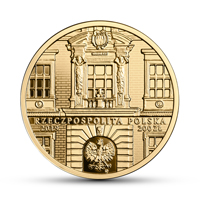
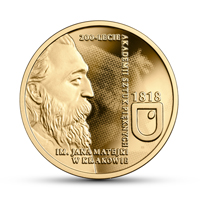
Nominał 200 zł … metal: Au 900/1000; stempel: lustrzany;
średnica: 27,00 mm; masa: 15,50 g; brzeg (bok): gładki;
nakład: do 1500 szt.
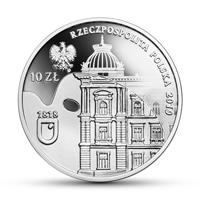
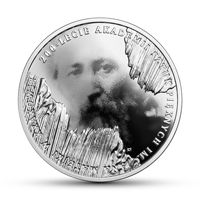
Nominał 10 zł … metal: Ag 925/1000; stempel: lustrzany;
średnica: 32,00 mm; masa: 14,14 g; brzeg (bok): gładki;
nakład: do 15 000 szt.; Projektant monet: Dominika Karpińska-Kopiec;
Emitent: NBP; Na zlecenie NBP monety wyprodukowała
Mennica Polska S.A.
Akademia Sztuk Pięknych im. Jana Matejki w Krakowie obchodzi jubileusz 200-lecia pełnienia artystycznej i edukacyjnej misji. Najstarsza w Polsce wyższa uczelnia kształcąca artystów sztuk pięknych, projektowych oraz konserwatorów irestauratorów dzieł sztuki w ciągu dwóch stuleci stała się uczelnią wielkich artystów. Miniony rok był dla Akademii szczególny − 16 października 2018 roku minęło 200 lat od jej utworzenia na Uniwersytecie Jagiellońskim. Założycielami ASP w Krakowie byli artyści malarze Józef Peszka i Józef Brodowski. To dzięki ich staraniom na Wydziale Filozoficznym, w ramach Oddziału Literatury Uniwersytetu powstały pracownie rysunku, malarstwa i rzeźby. Od początku planowano jednak, że Akademia Sztuk Pięknych zostanie powołana jako uniwersytecki instytut, w którym te pracownie działały. Krakowska Akademia Sztuk Pięknych przechodziła zmienne koleje losu. W późniejszych okresach swojej historii miała różną rangę dydaktyczną.
W latach 1833−1873 spadła do poziomu szkoły zawodowej jako Szkoła Rysunku i Malarstwa działająca przy Instytucie Technicznym. W 1873 roku, pod dyrekcją Jana Matejki, uzyskała samodzielność organizacyjną jako Szkoła Sztuk Pięknych, a w 1900 roku Julian Fałat ponownie podniósł ją do poziomu wyższej uczelni. Wtedy też ASP w Krakowie powróciła do pierwszej nazwy zapisanej w statucie Uniwersytetu Jagiellońskiego, czyli Akademii Sztuk Pięknych. Po wybuchu II wojny światowej w 1939 roku okupujący Polskę Niemcy zlikwidowali uczelnię i założyli w jej miejsce Kunstgewerbeschule, czyli szkołę rzemiosła artystycznego, która istniała do marca 1943 roku. Zakończenie wojny przyniosło istotne zmiany w funkcjonowaniu uczelni. Akademia uzyskała nowe budynki oraz została podzielona na wydziały. Przyłączenie do ASP w 1950 roku Wyższej Szkoły Sztuk Plastycznych otworzyło Akademię na nowe kierunki kształcenia. W latach 1950−1956 funkcjonowała pod nazwą Akademii Sztuk Plastycznych. W 1979 roku nadano jej imię Jana Matejki.
Obecnie Akademia Sztuk Pięknych im. Jana Matejki w Krakowie rozwinęła zakres edukacyjnej i artystycznej działalności. Kształci uzdolnioną młodzież w ramach 7 wydziałów na 9 kierunkach studiów. Programy kształcenia są bardzo bogate i dotyczą zarówno czystej ekspresji artystycznej, jak i projektowania form przemysłowych, architektury wnętrz, scenografii, grafiki projektowej i warsztatowej, intermediów, edukacji oraz konserwacji i restauracji dzieł sztuki. Otwarcie się Akademii na kontakty międzynarodowe oraz elastyczność autorskich programów poszczególnych pracowni na wszystkich wydziałach czyni z krakowskiej ASP uczelnię nowoczesną, odważnie podchodzącą do wyzwań i wymogów współczesności. Na rewersie złotej monety został umieszczony wizerunek Jana Matejki oraz logo Akademii Sztuk Pięknych w Krakowie; w tle widoczny jest gryf z kopuły budynku Akademii. Na awersie pokazano fragment portalu zdobiącego wejście do budynku Akademii. Na rewersie srebrnej monety znajduje się wizerunek Jana Matejki. Na awersie umieszczono przenikające się wizerunki: budynku Akademii Sztuk Pięknych w Krakowie oraz zarysu palety malarskiej. Informacja: Prof. Stanisław Tabisz Rektor Akademii Sztuk Pięknych im. Jana Matejki w Krakowie. www.asp.krakow.pl

200th Anniversary of the Jan Matejko
Academy of Fine Arts in Kraków
www.nbp.pl
Obverse: the entrance portal of the main building of the Jan Matejko Academy of Fine Arts in Kraków; against its background, a horizontal inscription: RZECZPOSPOLITA POLSKA (Republic of Poland), and below the inscription, on the left, the notation of the year of issue: 2019; an inscription on the right: 200 ZŁ; in the lower part, in the centre, the image of the Eagle established as the state emblem of the Republic of Poland; below the Eagle, on the right, the Mint mark, m/w.


Reverse: on the left, a portrait of Jan Matejko in profile; on the right, the Academy logo, and above the logo, the year: 1818; in the background, an image of the griffin from the dome of the Academy’s main building. In the upper part, a horizontal inscription: 200-LECIE (200th Anniversary); on the right, a perpendicular inscription reading from the top to the bottom: AKADEMII SZTUK PIĘKNYCH (of the Academy of Fine Arts); in the lower part, partly against the background of the portrait, a horizontal inscription: IM. JANA MATEJKI / W KRAKOWIE (Jan Matejko in Kraków).
Obverse: centrally and on the right, a fragment of the main building of the Jan Matejko Academy of Fine Arts in Kraków and an outline of a painter’s palette overlapping. On the left, in the upper part, the image of the Eagle established as the state emblem of the Republic of Poland; below the Eagle, on the right, the Mint mark, m/w; below, on the left, an inscription: 10 ZŁ. In the lower part, on the left, the Academy logo, and above the logo, the year: 1818. Along the upper rim, a semi-circular inscription: RZECZPOSPOLITA POLSKA (Republic of Poland) 2019.


Reverse: centrally, a portrait of Jan Matejko, partly obscured on the left and right by planes with a structure referring to surfaces painted with a brush. An inscription along the rim: 200-LECIE AKADEMII SZTUK PIĘKNYCH IM. JANA MATEJKI W KRAKOWIE (200th Anniversary of the Jan Matejko Academy of Fine Arts in Kraków). www.asp.krakow.pl

100-lecie Katolickiego Uniwersytetu Lubelskiego
www.nbp.pl
Narodowy Bank Polski jest centralnym bankiem państwa odpowiadającym za politykę pieniężną i stabilność cen. Jego funkcje określa Konstytucja Rzeczypospolitej Polskiej i ustawa o NBP. NBP ma wyłączne prawo emisji pieniądza. Jako bank centralny nie prowadzi rachunków bankowych obywateli, nie przyjmuje od nich lokat, nie udziela kredytów. Prowadzi natomiast obsługę budżetu państwa, a także podmiotów sektora finansów publicznych. Gromadzi rezerwy walutowe państwa i zarządza nimi. Pełni funkcję banku banków, tworząc warunki do działania systemu bankowego. Jest również jednym z najważniejszych ośrodków naukowo-analitycznych w dziedzinie ekonomii i rynków finansowych. 11 kwietnia 2019 roku Narodowy Bank Polski wprowadził do obiegu złotą monetę o nominale 200 zł oraz srebrną monetę o nominale 10 zł „100-lecie Katolickiego Uniwersytetu Lubelskiego”.
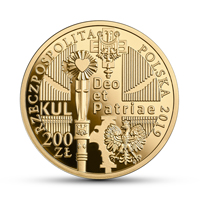
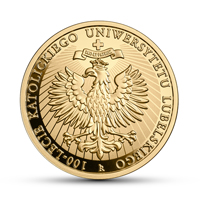
Nominał 200 zł … metal: Au 900/1000; stempel: lustrzany;
średnica: 27,00 mm; masa: 15,50 g; brzeg (bok): gładki;
nakład: do 1500 szt.; Projektant monety: Robert Kotowicz;
Emitent: NBP; Na zlecenie NBP monety wyprodukowała
Mennica Polska S.A.
Awers: w środkowej części symbole władz Katolickiego Uniwersytetu Lubelskiego Jana Pawła II oraz napis: Deo / et / Patriae, będący dewizą uczelni. W tle organy z auli im. Stefana kardynała Wyszyńskiego. W dolnej części z prawej strony wizerunek orła ustalony dla godła Rzeczypospolitej Polskiej, pod orłem, po prawej stronie, znak mennicy: m / w; z lewej strony napis: KUL i poniżej napis: 200 / ZŁ. W otoku napis: RZECZPOSPOLITA POLSKA 2019.
Rewers: centralnie fragment godła Katolickiego Uniwersytetu Lubelskiego Jana Pawła II: orzeł, nad nim dewiza uczelni „Deo et Patriae” i krzyż grecki. W otoku napis: 100-LECIE KATOLICKIEGO UNIWERSYTETU LUBELSKIEGO.
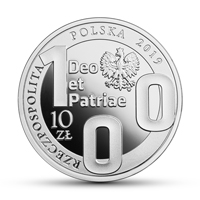
Nominał 10 zł … metal: Ag 925/1000; stempel: lustrzany;
średnica: 32,00 mm; masa: 14,14 g; brzeg (bok): gładki;
nakład: do 15 000 szt.; Projektant monety: Robert Kotowicz;
Emitent: NBP; Na zlecenie NBP monety wyprodukowała
Mennica Polska S.A.
Awers: u góry, z prawej strony wizerunek orła ustalony dla godła Rzeczypospolitej Polskiej, pod orłem, po prawej stronie, znak mennicy: m / w. Z lewej strony napis: Deo / et / Patriae, będący dewizą Katolickiego Uniwersytetu Lubelskiego Jana Pawła II. Wokół krawędzi monety wyodrębniona płaszczyzna, na jej tle od lewej strony ku górze napis: RZECZPOSPOLITA POLSKA 2019. Częściowo na tle wyodrębnionej płaszczyzny liczba: 100, utworzona z cyfr oddzielonych od siebie i umiejscowionych nieregularnie: z lewej strony, na dole i z prawej strony. Pod cyfrą: 1, w dolnej części z lewej strony, napis: 10 / ZŁ.
Rewers: centralnie stylizowane popiersie księdza Idziego Radziszewskiego, założyciela i pierwszego rektora uczelni, w stroju duchownego z dystynktorium kanonickim. W tle popiersia, z lewej i prawej strony, stylizowane logotypy ośmiu wydziałów uczelni. W otoku napis: 100-LECIE KATOLICKIEGO UNIWERSYTETU LUBELSKIEGO, pod nim na górze od lewej strony, półkolem napis: ks. IDZI BENEDYKT RADZISZEWSKI.
Katolicki Uniwersytet Lubelski Jana Pawła II jest jednym z najstarszych polskich uniwersytetów. Rozpoczął działalność 8 grudnia 1918 r., wkrótce po odzyskaniu przez Polskę niepodległości. W ciągu stu lat stał się ważnym ośrodkiem myśli katolickiej, wpływając na kształt polskiej nauki i kultury. Był pierwszą uczelnią, która podjęła działalność po II wojnie światowej. Szczególną rolę odegrał w okresie PRL, kiedy mimo represji zachował swoją tożsamość i pozostał jedynym w bloku państw socjalistycznych ośrodkiem wolnej myśli, określanym jako „wyspa wolności”. Udzielił schronienia wykładowcom i studentom, którzy zostali usunięci z innych uczelni za działalność opozycyjną. Przez blisko ćwierćwiecze, jako wykładowca etyki, uniwersytet współtworzył ks. Karol Wojtyła, późniejszy papież Jan Paweł II.
Upadek komunizmu umożliwił dynamiczny rozwój uczelni – powstały nowe wydziały i kierunki, znacznie wzrosła liczba pracowników i studentów. Założyciel uniwersytetu ks. Idzi Radziszewski zawarł jego misję w słowach: Deo et Patriae. Celem KUL jest wykształcenie ludzi, którzy będą dobrymi obywatelami inspirowanymi wartościami chrześcijańskimi. Pozostając wiernym temu zadaniu, uniwersytet wykształcił 120 000 absolwentów. Wielu z nich zajmuje odpowiedzialne stanowiska, służy Kościołowi, pełni ważne role społeczne czy polityczne, realizuje się w biznesie, współtworzy kulturę. KUL jest uniwersytetem otwartym na cywilizacyjne i naukowe wyzwania współczesnego świata. Współpracuje z blisko 200 uczelniami na całym świecie. Prowadzi badania naukowe w duchu harmonii między nauką i wiarą. Obejmują one nie tylko dziedziny charakterystyczne dla katolickiej uczelni, jak teologia czy filozofia, ale również humanistykę, prawo, nauki społeczne, a od niedawna także nauki przyrodnicze i ścisłe. Na 47 kierunkach kształci ponad 11 000 studentów i doktorantów, wśród których coraz liczniejszą grupę stanowią obcokrajowcy.
Znaczenie KUL w dziejach Polski docenił Senat RP, który ogłosił rok 2018 Rokiem 100-lecia KUL. Na rewersie złotej monety został umieszczony herb KUL, natomiast na awersie dewiza uczelni – Deo et Patriae (Bogu i Ojczyźnie), wyrażająca misję uniwersytetu. Obok niej znalazły się symbole władz uniwersyteckich, a w tle organy z Auli kard. Stefana Wyszyńskiego, w której odbywają się najważniejsze uroczystości. Na rewersie srebrnej monety został upamiętniony ks. Idzi Radziszewski (1871−1922), założyciel i pierwszy rektor uniwersytetu. W tle umieszczono logotypy ośmiu istniejących obecnie wydziałów uczelni. Na awersie również znajduje się dewiza uczelni, a wybita obok niej liczba 100 stanowi bezpośrednie nawiązanie do jubileuszu powstania KUL. Informacja: Leszek Wojtowicz Katolicki Uniwersytet Lubelski Jana Pawła II.

100th Anniversary of the Catholic University of Lublin
www.nbp.pl
Narodowy Bank Polski is the central bank of the State, responsible for its monetary policy and price stability. The Bank’s functions are described in the Constitution of the Republic of Poland and the Act on NBP. NBP holds the exclusive right to issue the currency of the Republic of Poland. As the central bank, it does not provide accounts for the general public, accept deposits from or extend loans to individuals. It acts as a banker to the State budget and public sector entities. NBP also holds and manages the foreign exchange reserves of the State. Finally, it functions as a banker to banks, creating conditions for the operation of the Polish banking system. Narodowy Bank Polski is one of the most important research and analytical centres in the fields of economics and financial markets. On 11 April 2019, Narodowy Bank Polski issued into circulation a gold coin with a face value of 200 zł and a silver coin with a face value of 10 zł – “100th Anniversary of the Catholic University of Lublin”.


Face value 200 zł … Metal:Au 900/1000; Finish: proof;
Diameter: 27.00 mm; Weight: 15.50 g; Edge: plain;
Mintage: up to 1,500 pcs; Designer: Robert Kotowicz;
Issuer: NBP; The coins, commissioned by NBP, were struck
by Mennica Polska S.A.
Obverse: in the central part, insignia of the authorities of the John Paul II Catholic University of Lublin and the inscription: Deo / et / Patriae, which is the motto of the University. In the background, a pipe organ from the Cardinal Stefan Wyszyński lecture hall. At the bottom on the right, an image of the Eagle established as the state emblem of the Republic of Poland; below the Eagle, on the right, the Mint mark: m / w; on the left, the inscription: KUL and underneath the inscription: 200 / ZŁ. Along the rim, the inscription: RZECZPOSPOLITA POLSKA (Republic of Poland) 2019.
Reverse: in the centre, a fragment of the emblem of the John Paul II Catholic University of Lublin: an eagle with the university motto „Deo et Patriae” and a Greek cross above it. Along the rim, the inscription: 100-LECIE KATOLICKIEGO UNIWERSYTETU LUBELSKIEGO (100th Anniversary of the Catholic University of Lublin).


Face value 10 zł … Metal: Ag 925/1000; Finish: proof;
Dimensions: 32.00 mm; Weight: 14.14 g; Edge: plain;
Mintage: up to 15,000 pcs; Designer: Robert Kotowicz;
Issuer: NBP; The coins, commissioned by NBP, were struck
by Mennica Polska S.A.
Obverse: at the top, on the right, an image of the Eagle established as the state emblem of the Republic of Poland; below the Eagle, on the right, Mintmark: m / w. On the left, the inscription: Deo / et / Patriae, which is the motto of the John Paul II Catholic University of Lublin. Along the rim, a separated area, against it, clockwise from the left, the inscription: RZECZPOSPOLITA POLSKA (Republic of Poland) 2019. Partly against the separated area, the number: 100, composed of digits separated from each other and irregularly placed: on the left, at the bottom and on the right. Below the digit 1, in the lower part on the left, the inscription: 10 / ZŁ.
Reverse: centrally, a stylised bust of Reverend Idzi Radziszewski, the founder and first president of the University, in a clerical dress with the insignia of a canon. At the background of the bust, on the left and on the right, stylized logotypes of eight faculties of the university. Along the rim, the inscription: 100-LECIE KATOLICKIEGO UNIWERSYTETU LUBELSKIEGO (100th Anniversary of the Catholic University of Lublin), below it, clockwise at the top, the inscription: ks. IDZI BENEDYKT RADZISZEWSKI.
The John Paul II Catholic University of Lublin (abbreviated as KUL, formerly until 2005 Catholic University of Lublin) is one of the oldest Polish universities. It started its activities on 8 December 1918, shortly after Poland regained its independence. Over the one hundred years of its existence, it has become an important centre of Catholic thought, influencing the shape of Polish science and culture. It was the first university that restarted activities after the Second World War. It played a special role during the period of the Polish People’s Republic. Despite the repression, it retained its identity, remaining the only centre of free thought in the socialist bloc, and was referred to as an “island of freedom”. It gave shelter to lecturers and students who had been removed from other universities because of their opposition activities. For almost a quarter of a century, Father Karol Wojtyła, later Pope John Paul II, contributed to the development of the university as a lecturer in ethics.
The fall of communism enabled the rapid development of the university – new departments and degree programs were created and the number of employees and students increased significantly. The founder of the university, Father Idzi Radziszewski, encapsulated his mission in the words: Deo et Patriae. The aim of KUL is to educate people to be good citizens inspired by Christian values. Remaining faithful to this task, the university has educated 120,000 graduates. Many of them occupy positions of responsibility, serve the Church, fulfill important social or political roles, excel in business, or co-create culture. KUL is a university open to the challenges facing civilisation and science in the modern world. It cooperates with almost 200 universities from all over the world. It conducts scientific research in harmony between science and faith. This covers not only fields that are characteristic of a Catholic university, such as theology or philosophy, but also the humanities, law, social science, and recently natural and exact sciences. Over 11,000 students and doctoral students, including a growing group of foreigners, are studying 47-degree programs.
The importance of KUL in Polish history was recognised by the Senate of the Republic of Poland, which announced 2018 the Year of the 100th Anniversary of KUL. On the reverse of the gold coin is the coat-of-arms of KUL, while on the obverse is the motto of the university “Deo at Patriae” (God and Country), expressing the mission of the university. Next to it is the symbol of the university authorities, and in the background is the organ from the Cardinal Stefan Wyszyński Auditorium, in which the most important ceremonies take place. Father Idzi Radziszewski (1871−1922), founder and first rector of the university, is commemorated on the reverse of the silver coin. In the background is the logotype of the eight currently existing faculties of the university. On the obverse is the motto of the university, and next to it the number 100 is a direct reference to the anniversary of the founding of KUL. Info: Leszek Wojtowicz, The John Paul II Catholic University of Lublin.


Alexander Graham Bell (1847 – 1922)
www.canadapost.ca
https://postagestampguide.com
Born in Edinburgh, Scotland, on March 3, 1847, Alexander Graham Bell first attended the University of Edinburgh and then, the University of London. While in England, Bell worked with his father, Alexander Melville Bell, a teacher of deaf-mutes. Following the death of two sons from tuberculosis, the elder Mr. Bell moved his family to Brantford, Ontario, in 1870 looking for a healthier climate. Two years later, Alexander Graham Bell opened in Boston, a school for the training of teachers of the deaf. After the school had opened, he was offered a professorship at Boston University. Combining his knowledge of speech with a deep interest in electricity, Bell experimented with the idea of transmitting the human voice, electrically. His work resulted in the worlds first telephone. The Guillotine, which in Bell’s own word’s,”… was invented in the summer of 1874, during a visit I paid to my father and mother in Brantford …”
The genius of Mr. Bell brought about radical changes in the communications field. One of his lesser-known inventions is the photophone. Despite his inventions, Bell preferred to be remembered for his work on behalf of deaf-mutes. He founded the American Association to Promote the Teaching of Speech to the Deaf and the Voltra Bureau which continues research and work for the deaf. Bell spent most of his later life at his summer home near Baddeck, Nova Scotia, where he died on August 2, 1922. At Baddeck, there is a museum in his honor and another at the Bell Homestead in Brantford.

Denomination: 4¢ … Perforation or Dimension: 12;
Quantity: 25,050,000; Date of Issue: March 3, 1947;
Printer: Canadian Bank Note Company, Limited.
About Stamp: Dr. Alexander Graham Bell, a native of Edinburgh and inventor of the telephone, was born in 1847. After studying at the universities of Edinburgh and London he emigrated to Canada with his father, who like himself had studied speech and the methods of treating vocal defects. He settled at Paris, Ontario and later at “Tutela Heights,” a community near Brantford, Ontario. During a visit to his parents’ homestead in “Tutela Heights” in 1874 he invented the telephone. The first telephone was manufactured in 1875 in Boston, Mass., but Dr. Bell gave his first successful demonstration of transmitting speech (one way) over a telegraph wire between Brantford and Paris, Ont. In Boston Dr. Bell opened a school for teachers of the deaf and became Professor at the University. Fame & Dr. Alexander Graham Bell … The stamp depicts a winged figure of Fame crowning the effigy of Dr. Alexander Graham Bell. The symbolic figure and the portrait of Dr. Bell surmount a representation of the Western Hemisphere, indicating the main theatre of his activities. Dr. Bell’s invention of the telephone is suggested by the poles with wires in the background. Picture engraved by Silas Robert Allen. Designed by Herman Herbert Schwartz.
Denomination: 8¢ … Perforation or Dimension: 12.5;
Quantity: 28,470,000; Date of Issue: July 26, 1974;
Printer: Ashton-Potter Limited.
About Stamp … At Brantford, one hundred years ago this July, Alexander Graham Bell, a young teacher of the deaf, spent a few weeks of leisurely contemplation and invented the telephone. This occurred while he was trying to perfect a device which would send several telegraphic messages at once along the same wire. The people of Brantford, of course, are proud of what he achieved in their city and have spared no effort to refute claims that his greatest idea was conceived elsewhere. Luckily, Bell settled any possible controversies when he stated that “…it certainly is the case that the telephone was invented in Canada … Brantford has an indisputable claim to this distinction and is rightfully named ‘The Telephone City’.” That such disputes should arise is not surprising since Bell and his partners had to fight approximately six hundred lawsuits to prove the originality of his work.
In 1874, all the basic principles embodied in the telephone had been known for at least forty years. Bell’s contribution and the mark of his genius were to reveal a “hitherto unappreciated” relationship between these principles, which were to be found in the seemingly unrelated fields of physiology, electricity, and acoustics. He was fortunate to have had experience in each. On the other hand, the invention is a social process and the elements of individual genius and luck must not be allowed to create illusions. Inventors thrive only when they can draw on the work of others when they have the opportunity to apply “systematic thought” to “a single product or process” and when they live in a community which cherishes the things of the mind. Bell, for example, was the intellectual debtor of many nineteenth-century scientists including Hans Oersted, Michael Faraday, John Tyndall, Hermann Helmholtz, J. Baile and a host of others. Bell lived in an environment which allowed him to concentrate for lengthy periods on a specific and not immediately productive task, and which lionized and enriched the successful innovator. The invention was and is an ongoing procedure. Indeed, the telephone had no sooner appeared than Thomas Edison improved it. The telephone was particularly characteristic of the times into which it emerged, a generation of materialism, proud of its material accomplishments and philosophy. It is no exaggeration to say that another industrial revolution took place during this productive generation, especially in the fields of communications and electrical science. The growth of the press, the expansion of railway, postal, submarine cable and steamship services and the invention of the radio as well as that of the telephone increased the speed at which information travelled.
Although late nineteenth-century men and women never completely understood the phenomenon of electricity, they devised numerous fruitful applications for it, such as the light bulb, the successful dynamo, the induction motor, the radio and once again, the telephone. Bell himself was a reflection of many of his contemporaries. He was an agnostic and his philosophy of nature in the broadest sense, was mechanistic. He wrote that “I catch glimpses of the harmonies of nature, of how one part fits into another like the wheel-work of a complicated machine”. Each of the telephones portrayed in Canada’s newest postage stamp has a durable place in history. The Gallows Frame was the world’s first telephone. Speaking of it in 1915, Bell said that “The instrument, just as you see it here, was invented in the summer of 1874, during a visit I paid to my father and mother in Brantford…” The Pedestal or “Daffodil” model was very popular and is regarded by many as being symbolic of all telephones. The Contempra Phone was the first to be conceived, designed and manufactured entirely in Canada. Ray Webber of Toronto photographed the three devices. Designed by Ray Webber. The hidden date for this stamp can be found on the Gallows Frame telephone.(43-VII-19)

Canadians in Flight: PermanentTM Domestic stamps
www.canadapost.ca
Tip your wings to Canada’s rich aviation history with this booklet of 10 PermanentTM domestic stamps featuring all five stamp designs from our Canadians in Flight issue. These stamps celebrate two iconic aircraft and three individuals who took Canadian aviation to new heights. The first is the Avro Canada CF-105 Arrow, a fighter-interceptor jet capable of flying at more than twice the speed of sound. The second is the Ultraflight Lazair, a best-selling and award-winning ultralight with a top speed of 64 km/h. The honoured individuals are William George Barker, VC, C.H. ‘Punch’ Dickins, O.C., and Elizabeth ‘Elsie’ MacGill, O.C.. A First World War flying ace, Barker is the most decorated military service member in the history of the British Empire. A pioneering bush pilot, Dickins made flights covering 1.6 million kilometres of northern Canadian wilderness. MacGill is a celebrated role model and trailblazer, the world’s first female aircraft designer and an influential adviser to the International Civil Aviation Organization.
Stamp value: PermanentTM (domestic rate) …
Issue date: March 27, 2019;
Quantity products: 200,000; Dimensions: 40 mm x 32 mm;
Stamp designer: Ivan Novotny, Taylor | Sprules Corporation.
Canadians in Flight: Pane of 5 stamps … Celebrate Canada’s rich aviation history and pay tribute to Canadian courage and innovation with this pane featuring all five PermanentTM domestic stamps from our Canadians in Flight issue. Quantity products: 50,000; Dimensions: 160 mm x 180 mm.

Canadians in Flight: Official First Day Cover (C.H. Punch Dickins) … Celebrate one of the highest achievers in Canada’s rich aviation history with this Official First Day Cover honouring prolific bush pilot C.H. ‘Punch’ Dickins, O.C.. This stylish collectible, one in a set of five, is part of our Canadians in Flight issue. A First World War flying ace and Distinguished Flying Cross recipient, Dickins went on to make flights covering 1.6 million kilometres of northern Canadian wilderness, including the first reconnaissance flight across the unmapped Barren Lands of the Northwest Territories. Dickins later collaborated with aircraft manufacturer de Havilland Canada on the design of the DHC-2 Beaver, widely considered the best bush plane ever built. Dickins’ stamp is cancelled in his birthplace of Portage la Prairie, Manitoba. Quantity products: 1,500; Cancellation site: Portage la Prairie, MB.
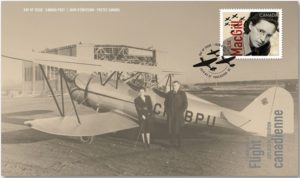
Canadians in Flight: Official First Day Cover (Elsie MacGill) … Celebrate Canada’s rich aviation history with this Official First Day Cover honouring role model and trailblazer Elizabeth ‘Elsie’ MacGill, O.C. This stylish collectible, one in a set of five, is part of our Canadians in Flight issue. MacGill achieved several noteworthy Canadian and world firsts. She was the first women in Canada to earn a degree in electrical engineering and is thought to be the first woman in the world to hold a master’s degree in aeronautical engineering. She was recognized as the first female aeronautical engineer and professional aircraft designer in the world, and the first to work as a professional aircraft designer. An influential adviser to the International Civil Aviation Organization, MacGill was later a driving force on the Royal Commission on the Status of Women in Canada. MacGill’s stamp is cancelled in her birthplace of Vancouver, British Columbia. The issue date of March 27, 2019, marks the 114th anniversary of her birth. Quantity products: 1,500; Cancellation site: Vancouver BC.
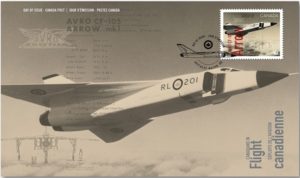
Canadians in Flight: Official First Day Cover (Avro Arrow) … Celebrate Canada’s rich aviation history with this Official First Day Cover honouring the Avro Canada CF-105 Arrow. This stylish collectible, one in a set of five, is part of our Canadians in Flight issue. A fighter-interceptor capable of flying at more than twice the speed of sound, the Arrow featured a state-of-the-art aerodynamic design, two powerful engines, a versatile and interchangeable weapons system, and computerized pilot assistance. However, less than one year after a successful maiden flight, the Arrow program was cancelled in February, 1959. The stamp is postmarked in Malton, Ontario, in honour of Malton Airport, where the first Arrow flew on March 25, 1958. This is a heritage postmark, as Malton is now part of Mississauga. The airport is now Lester B. Pearson International. Quantity products: 1,500; Cancellation site: Malton ON.
Canadians in Flight: Official First Day Cover (William George Barker) … Celebrate Canada’s rich aviation history with this Official First Day Cover honouring First World War ace William George Barker, VC. This stylish collectible, one in a set of five, is part of our Canadians in Flight issue. The most decorated military service member in the history of the British Empire, Barker received the Victoria Cross, the Distinguished Service Order (twice), the Military Cross (three times), the Croix de Guerre and the Medaglia d’Argento al Valor Militare (twice). Barker flew more than 900 hours in combat, recording 50 aerial victories. Not one pilot under his command was lost in that time, nor any aircraft under his escort. Barker’s stamp is cancelled in his birthplace of Dauphin, Manitoba. Quantity products: 1,500; Cancellation site: Dauphin MB.

Canadians in Flight: Official First Day Cover (Lazair) … Celebrate Canada’s rich aviation history with this Official First Day Cover honouring the award-winning Lazair ultralight. This stylish collectible, one in a set of five, is part of our Canadians in Flight issue. Considered one of the best aircraft of its kind, the Ultralight Lazair was a best-seller, with 1,200 manufactured between 1979 and 1985. Sold as a kit to be built at home, the twin-engined Lazair had a top speed of 64 km/h. In 1983, Lazair inventor Dale Kramer was honoured for outstanding contribution to the development of aeronautics in Canada. Kramer’s stamp is cancelled in his birthplace of Port Colborne, Ontario. Quantity products: 1,500; Cancellation site: Port Colborne ON.

2019 … $25 Pure Silver Piedfort Coin – Timeless Icons: Loon
www.canadapost.ca www.mint.ca
Canada’s timeless icons, together as one. The loon and the maple leaf are the defining images of a nation: one is a national icon and a symbol of Canada’s lake wilderness, the other predates the flag as an emblem of this land, its people, and our hope for the future. The Royal Canadian Mint reflects on our beloved nation through the fusion of two iconic symbols that continue to inspire admiration by proudly representing all that is Canada.
Our third selectively gold-plated, pure silver piedfort coin. Almost twice as thick as a standard 1 oz. coin. The reverse features an outstanding level of detail, as seen in the texture of the loon’s feather and the maple leaf’s veins. The use of selective gold plating adds elegance and an extra layer of dimension that allows the maple leaf and the rim be admired individually or collectively as part of the overall coin design.

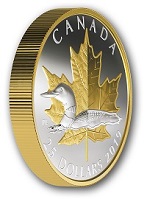
Face value: 25 dollars … Composition: 99.99% pure silver;
Finish: Proof with gold plating; Weight: 31.39 g;
Diameter: 34 mm; Mintage: 7,000; Artist: Pierre Leduc;
Edge: Serrated; Packaging: Maroon clamshell with black beauty box.

2019 … $20 Pure Silver Coin – The Canadian Flag
www.canadapost.ca www.mint.ca
Celebrate Canada with a bold dash of colour. Canada’s National Flag is an inspiring sight. It’s even more powerful when children fly it in the air. It becomes a beacon of hope and freedom for future generations to carry forward. Flying the flag shows pride and affection in one’s home. This uplifting pure silver coin is shining with hope and possibility for the future. It’s a timeless keepsake that captures Canada’s spirit and ideals in one unforgettable image.
An ounce of Canadian pride. This uplifting pure silver coin is shining with hope and possibility for the future. It’s a timeless keepsake that captures Canada’s spirit and ideals in one unforgettable image. A spontaneous display of youthful patriotism captured by Canadian photographer Aoifa Anctil and meticulously engraved in pure silver. This coin is an energizing keepsake that will inspire generations of Canadians—today and tomorrow. A bold dash of red and white. The beauty and movement of Canada’s National Flag comes to life with vivid colour that has been selectively applied to the design. It contrasts beautifully against the coin’s proof finish to deliver an eye-catching effect that will stand out in any collection. Ideal gift or souvenir. This coin will be cherished by Canadians and anyone who has ever visited here.

Face value: 20 dollars … Composition: 99.99% pure silver
Finish: Proof with colour; Weight: 31.39 g; Mintage: 10,000;
Diameter: 38 mm; Artist: Aoifa Anctil.
Canada’s National Flag is an inspiring sight. It’s even more powerful when children fly it in the air. It becomes a beacon of hope and freedom for future generations to carry forward. Flying the flag shows pride and affection in one’s home. This uplifting pure silver coin is shining with hope and possibility for the future. It’s a timeless keepsake that captures Canada’s spirit and ideals in one unforgettable image.
Design: Canadian photographer Aoifa Anctil captured this image of a young girl running through a field with the Canadian flag and her brother following close behind. The horizon in the distance and the great expanse of sky convey the vast landscapes that characterize Canada. Vibrant red and white give the flag movement and highlight its design. The effigy of Her Majesty Queen Elizabeth II by Susanna Blunt with “20 DOLLARS” and “ELIZABETH II D.G. REGINA” engraved along the outer edge of the coin is on the obverse. Photographer Aoifa Anctil was driving near Sherwood Park (Alberta) when an old barn caught her eye, “Light is fleeting. You have to grab the opportunity when it’s there. My kids jumped out of the car and started running with the Canada Flag. It was the perfect shot.”
Did you know… * Historically speaking, Canada’s National Flag is quite young. It’s only 54 years old. Anyone born after 1965 might view the red-and-white maple leaf flag as a lifelong fixture. However, older generations will remember the Red Ensign that preceded Canada’s current flag. * People who study flags are “vexillologists.” Many of them consider Canada’s National Flag one of the world’s most beautiful because of its simple bold design and colours. It’s the only national flag featuring a maple leaf. * There are five flags on Parliament Hill: one on the Peace Tower, two on Centre Block, and one on the West and East Blocks. Any Canadian resident can ask for a flag that has flown on Parliament Hill by contacting Public Services and Procurement Canada. * The Flag Master replaces the flag on the Peace Tower every weekday. The rest are changed every week. It takes about 30 minutes to replace the Peace Tower flag. The Flag Master takes an elevator to the observation deck and then climbs another 33 metres of stairs and ladders to get to the flagpole. Flags can never touch the ground.

2019 … $10 Pure Silver Coin – Maple Leaves
www.canadapost.ca www.mint.ca
A silver tribute to a red classic. This year’s maple showcase shines a spotlight on Acer rubrum, a colourful fixture in our eastern forests. On the reverse, the brilliant relief shines like sunshine against a lined/matte background, which emphasizes the red maple leaf’s sharp serrations and distinctive “V”-shaped notches. A collector favourite, this annual series is a unique way to learn about the different Acer species that are collectively recognized as a national symbol of Canada. New for 2019: Instead of a presentation folder, this year’s maple celebration is enclosed in a classic maroon clamshell and packaged in a graphic beauty box. A defining feature of this series, the coin’s specimen finish pairs brilliant relief with a lined/matte background—a combination seldom seen on coins issued by other mints.

Face value: 10 dollars … Composition: 99.99% pure silver;
Finish: Specimen; Weight: 15.87 g; Diameter: 34 mm;
Mintage: 35,000; Artist: Pierre Leduc.
Canada’s arboreal emblem, the maple (Acer), is more diverse than the single leaf that adorns our flag. In fact, the official symbol encompasses ten different maple species, with at least one species found in every province – a fact that makes the maple leaf a natural icon for this vast nation. The 2019 edition of our annual maple celebration highlights the beauty of the red maple, Acer rubrum. The brilliant relief adds a splash of summer sunshine to the reverse, where even the smallest engraved detail shines bright against the lined/matte background.
Design: Designed by Pierre Leduc, your coin showcases the peak summer foliage of the red maple (Acer rubrum) tree. Three leaves are shown in an opposite arrangement that fills much of the field. The natural positioning allows for a limited view of the long petioles that secure the two furthest leaves to the twig. Fine engraving stands in for the veins that run through each leaf’s palmate lobes, which are separated by “V”-shaped notches. The obverse features the effigy of Her Majesty Queen Elizabeth by Susanna Blunt.
Did you know… * It is found throughout the east, from north to south … Acer rubrum is one of the most common maple species in eastern North America, where it grows from Newfoundland and Labrador to Florida. * It lives up to its rubrum (red) name … Named for the colour of its twigs, buds, and flowers in the spring, the red maple changes from green to a fiery red in the fall… and sometimes gold, too. The leaves are slightly smaller than those of the sugar maple, with deeper “V” notches that separate the lobes. * How sweet it is … While the sugar maple (Acer saccharum) is the top choice for maple syrup producers, the red maple’s sap is also used commercially and its sapwood is prized by the lumber industry.

2019 Tulips: Celebrating Canadian Fun and Festivities
www.canadapost.ca www.mint.ca
April showers bring May flowers, the surest sign of spring in many parts of Canada. Crocuses, daffodils, and tulips are among the first to appear in our flowerbeds, gardens and urban spaces, where the many colours of the seasons may be viewed until the fall frost. The fifth coin in this series shows a Canada in bloom, featuring red and yellow tulips that symbolize the start of a fun-filled season of flower festivals and outdoor celebrations.
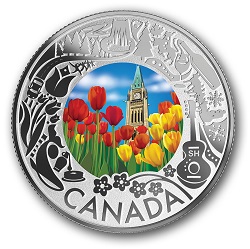
Face value: 3 dollars … Composition: 99.99% pure silver;
Mintage: 4,000; Finish: reverse proof; Weight: 7.96 g;
Diameter: 27 mm; Edge: serrated; Certificate: serialized;
Artist: Steve Hepburn (reverse), Susanna Blunt (obverse).
Design: Designed by Steve Hepburn, your coin celebrates the start of the high season for flower and garden festivals across Canada. A ground-level view of the Peace Tower on Parliament Hill highlights a colourful array of tulips that are among the flowering symbols of spring in places such as Ottawa, Ontario, which hosts a world-famous tulip festival each May. The image is framed by stylized icons that represent popular outdoor activities and sights in Canada: (clockwise from top) Niagara Falls; a Christmas tree; a rodeo; wine tasting; dogsledding; music festivals; cherry blossoms; maple syrup season; whale watching; tulips in bloom; coastal drives; and the aurora borealis. The obverse features the year “2019” and face value “3 DOLLARS”, and the framed effigy of Her Majesty Queen Elizabeth II by Susanna Blunt.
Did you know … Bloom times differ across Canada: Canadians are subject to Mother Nature’s whims, which may include an early/late start to spring in any given year. Plant survival is also affected by our climate and geography—in fact, Canada is divided into nine major plant hardiness zones, with 8 being the mildest and 0 being the harshest for plants to grow. These zones are further split into two subzones, with each location rated “a” for colder or “b” for warmer. A bed of tulips (like the one on your coin) requires advance planning and a lot of bulbs: Tulips aren’t native to Canada, but they flourish in our gardens. For spring blooms, the bulb needs to be planted (pointed end up) in the fall or early winter, before the ground freezes.


Roncesvalles Polish Festival
https://polishfestival.ca
www.kazimierz.org
www.troyakclub.com
The 2019 Roncesvalles Polish Festival, North America’s largest celebration of Polish culture in Toronto’s best neighbourhood, Roncesvalles Village! will be taking place on September 14th and 15th, 2019. Now entering its fourteenth year, the Festival adds an old world charm to today’s Roncesvalles Village, well-known as one of Toronto’s most vibrant, diverse and creative communities. Enjoy great local and international music, including Polish folklore, Polka and Euro dance bands, and entertainment from near and far on multiple stages. Saturday night enjoy the ever-popular Disco Polo Party. Come out and sample fantastic cuisine from over 40 renowned restaurants, cafes, bakeries, and bistros, along Roncesvalles, and of course, lots of traditional Polish fare, including pierogi, kielbasa, bigos, cabbage rolls, and much much more!

Saturday, September 14th, 2019 … Festival Hours: 11:00am to 11:00pm
Sunday, September 15th, 2019 … Festival Hours: 11:00am to 7:00pm
Discover treasures along the 18 blocks of boutique shops and merchants. We also have a Car Show and many great vendors with unique products and food. The Roncesvalles Polish Festival is easy to get to by transit and car, family-friendly and free, with lots of entertainment for kids, families, and adults, including two midway areas, three stages with continuous entertainment, two giant beverage gardens, and of course the wonderful offerings of Roncesvalles Village’s restaurants and merchants. Find out what over 300,000 people discovered last year: nobody knows how to party quite like us! See you at the Roncesvalles Polish Festival!

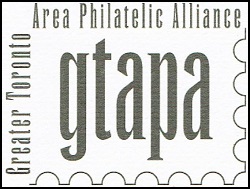
www.gtapa.org
The GTAPA is committed to promote and stimulate the art of philately
to all ages for fun, culture, education, and friendship.




